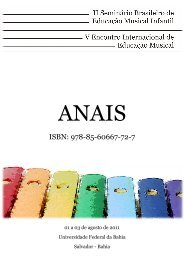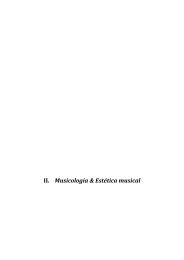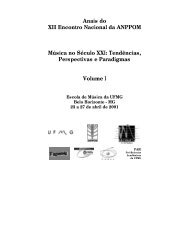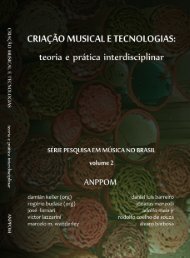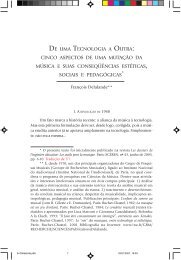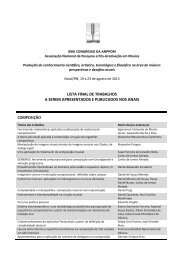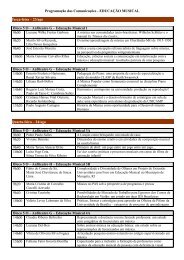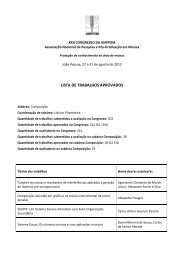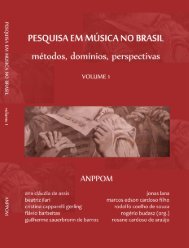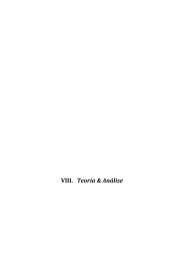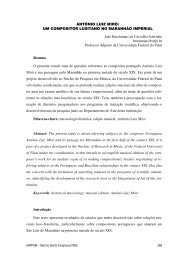download da versão impressa completa em pdf - anppom
download da versão impressa completa em pdf - anppom
download da versão impressa completa em pdf - anppom
Create successful ePaper yourself
Turn your PDF publications into a flip-book with our unique Google optimized e-Paper software.
. . . . . . . . . . . . . . . . . . . . . . . . . . . . . . . . . . . . . . . . . . . . . . . . . . . . . . . . FORNARI; SHELLARD; MANZOLLI<br />
They are: (1) Proliferation, which describes the rate of reproduction in the Population set;<br />
(2) Lifespan, that sets the average of how long each individual, in the Population set, can be<br />
alive; (3) Crossover, that sets the amount of crossover, or recombination, during the<br />
reproduction process; and (4) Mutation rate, which sets the amount of mutation in the new<br />
individuals' genotype.<br />
The Population set, in this version of ESSynth, starts with only two individuals (two<br />
instantiations of a PD abstraction). Its size grows as the reproduction process creates new<br />
individuals, and reduces when the individuals' lifespan is over. During the evolutionary<br />
process, new individuals will be born, thus creating sound objects, and old individuals will<br />
die, when the correspondent sound object also disappears. The ESSynth sound output is<br />
given by all individuals alive, which creates an <strong>em</strong>ergent sound realm by all active individuals<br />
within the Population set. Individuals will also independently move around. The location of<br />
each sound object is given by simple Interaural Time Difference (KELLY; PHILLIPS, 1991)<br />
and Interaural Loudness Difference (BIRCHFIELD; GANGISHETTY, 2005) sound location<br />
algorithms.<br />
Here, individuals don't have gender differentiation, but will – in pairs – generate<br />
offsprings. Genetic operators: Crossover and Mutation ass<strong>em</strong>ble the offsprings new<br />
genotypes from the genotypes <strong>da</strong>ta of their two parents. Each genotype has six<br />
chromosomes, given by arrays of floating-points. They are separated in two sets of three<br />
arrays, controlling sound synthesis characteristics: Tonal and Stochastic. Tonal set<br />
synthesizes sound with clear pitch. Stochastic one synthesizes sounds without clear pitch.<br />
Each group of 3 arrays control synthesis characteristics related to Intensity, Frequency and<br />
Distortion. Intensity controls the sound intensity of each set. Frequency is associated with<br />
pitch (for the Tonal set), which is the center frequency filter (for the Stochastic one).<br />
Distortion controls the amount of partials in the Tonal set, and the filter bandwidth, in the<br />
Stochastic set. It is interesting to realize that the Distortion parameter works as a bridge<br />
between Tonal and Stochastic features. Without distortion, Tonal set generates a sine-wave<br />
sound and the Stochastic one, a white-noise. As the Distortion rate increases, Tonal output<br />
increases the number of partials, by clipping the sine-wave, thus making it more similar to a<br />
square-wave; and the Stochastic output by narrowing the filter center-band, generates a<br />
sound similar to a whistle.<br />
As shown in Figure 1, each array is a time series that describes the progression of<br />
one parameter along of the individual lifespan. Each array has a fixed length of 100 el<strong>em</strong>ents,<br />
that are real numbers, normalized between [-1,+1]. These 6 arrays compound the individual<br />
genotype. In the syst<strong>em</strong>, they are given as a text file which contains a matrix M6,100 – the<br />
Gestural Matrix. From top to bottom, the 6 lines of the gestural matrix text file are: Tonal<br />
opus . . . . . . . . . . . . . . . . . . . . . . . . . . . . . . . . . . . . . . . . . . . . . . . . . . . . . . . . . . . . . . . . . . . . . . . . . . . . . 139



